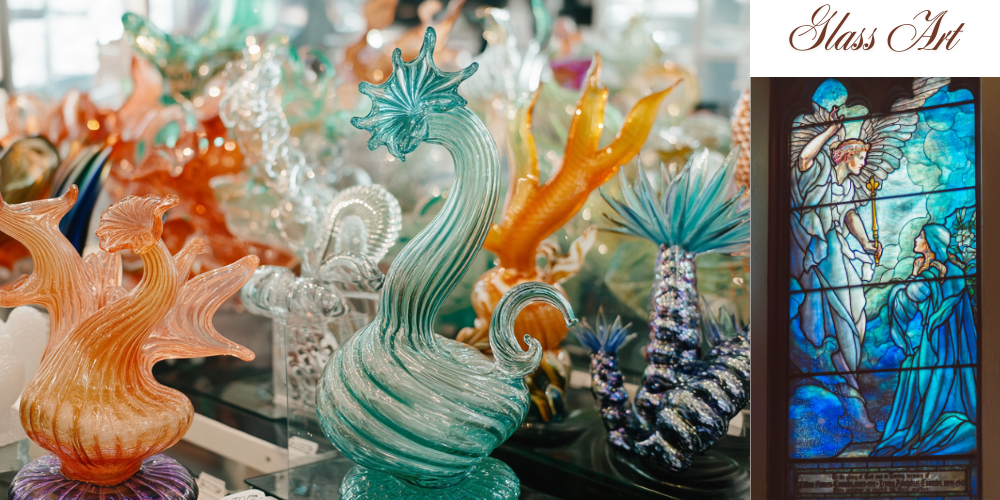Glass, a material born of fire and sand, possesses a unique allure. Its transparency, its ability to capture and refract light, and its inherent fragility make it a captivating medium for artistic expression. From ancient utilitarian vessels to breathtaking contemporary sculptures, glass art has traversed millennia, evolving in technique and aesthetic, reflecting the cultures and technologies of its time. This blog post delves into the fascinating world of glass art, exploring its rich history, diverse techniques, and the visionary artists who continue to push its boundaries.
A Glimpse into the Past: The History of Glass Art
The story of glass art is as old as glass itself. Evidence suggests that the earliest glass objects, primarily beads, originated in Mesopotamia around the 3rd millennium BCE. The art of glassblowing, a revolutionary technique that allowed for the creation of hollow vessels and more complex forms, emerged in the Roman Empire during the 1st century BCE. This innovation democratized glass production, leading to its widespread use in both functional and decorative objects.
Roman glassmakers were masters of millefiori (thousand flowers) techniques, creating intricate patterns by fusing multicoloured glass rods. They also excelled in cameo glass, carving intricate designs into layered glass. The Portland Vase, a masterpiece of Roman cameo glass, stands as a testament to their skill and artistry.
Stained glass windows emerged, particularly in the Middle Ages, turning cathedrals into bright spots filled with colours and stories from the bible. The methods of making stained glass, using lead cames to keep pieces of coloured glass together, were honed with care to create a craft handed down from generation to generation of craftsman. The glorious rose windows of Gothic cathedrals, with the light washed through stained glass, are awe-inspiring examples of this art form.
There was a resurgence of interest in classical art and design during the Renaissance, including through glassmaking techniques and styles. Venice and its island of Murano became an important glassmaking centre, especially for Cristallo glass, a clear and colourless glass that was highly prized for its clarity. Venetian glassmakers invented new methods of production, producing filigree, latticino, and aventurine, creating exquisite, unique, and intricate works of art.
The 19th century saw the rise of Art Nouveau, a movement that embraced organic forms and natural motifs. Émile Gallé, a leading figure in the Art Nouveau movement, revolutionized glassmaking with his cameo glass and innovative use of colour and texture. His works, inspired by nature, captured the spirit of the era.
The Spectrum of Techniques: Shaping Glass into Art
The world of glass art encompasses a diverse range of techniques, each offering unique possibilities for artistic expression.
- Glassblowing: This ancient technique requires inflating molten glass with a blowpipe, giving the artist the ability to shape and form the glass into a number of shapes. It takes skill, precision, and a knowledge of the properties of hot glass.
- Lampworking: Also known as flameworking, this technique uses a torch to heat and manipulate glass rods, creating intricate beads, small sculptures, and other decorative objects. Lampworking allows for detailed work and the use of multiple colours.
- Fusing: This technique involves heating pieces of glass together in a kiln until they fuse, creating larger panels or three-dimensional forms. Fusing allows for the creation of complex patterns and the incorporation of different materials.
- Slumping: Similar to fusing, slumping involves heating glass in a kiln over a mould, allowing the glass to go along to the shape of the mould. This technique is often used to create bowls, plates, and other functional objects.
- Casting: This technique involves pouring molten glass into a mould, allowing it to solidify into the desired shape. Casting is often used to create larger sculptures and more complex forms.
- Stained Glass: This traditional technique involves cutting coloured glass into specific shapes and assembling them with lead cames. Stained glass is often used to create windows and other decorative panels.
- Coldworking: This encompasses a variety of techniques used to shape and refine cold glass, including cutting, grinding, polishing, and engraving. Coldworking can be used to add details to blown or cast glass or to create entirely new works of art.
Contemporary Glass Art: Breaking Boundaries
Today, contemporary glass artists are pushing the boundaries of the medium, experimenting by using new techniques, incorporating unusual materials, and challenging traditional notions of what glass art can be.
Artists like Dale Chihuly, renowned for his large-scale, vibrant glass sculptures, have brought glass art to a wider audience. His works, often inspired by nature, are characterized by their bold colours, organic forms, and impressive scale.
Other contemporary glass artists are exploring the use of digital technologies in their work, creating interactive installations and incorporating light and sound into their sculptures. As artists continue to innovate and experiment, the possibilities of glass art seem endless.
Collecting Glass Art: A World of Beauty and Investment
Collecting glass art can be a rewarding experience, offering the opportunity to own unique and beautiful works of art. When starting a collection, it is important to research different artists, techniques, and styles. Visit galleries, attend exhibitions, and talk to other collectors to learn more about the world of glass art.
Consider the size, style, and price range of the pieces you are interested in. Also, consider the artist’s reputation and the provenance of the piece. Collecting glass art can be a significant investment, so it is important to do your research and make informed decisions.
Conclusion: The Enduring Magic of Glass
Glass art, in its myriad forms, continues to captivate and inspire. From ancient times to modern day, glass is a medium of infinite potential. Its inherent beauty, ability to interact with light, and versatility make it a truly unique art form. Whether you are a seasoned collector or simply an admirer of its beauty, the world of glass art offers a journey of discovery and wonder.
Disclaimer
This blog post is for informational purposes only and does not constitute professional art-collecting advice. It is based on general knowledge and research and should not be considered a substitute for consulting with art professionals or conducting your own thorough research.


